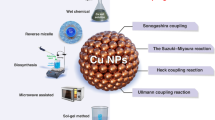Abstract
The reactivity of nitrite towards the copper(II) and copper(I) centers of a series of complexes with tridentate nitrogen donor ligands has been investigated. The ligands are bis[(1-methylbenzimidazol-2-yl)methyl]amine (1-bb), bis[2-(1-methylbenzimidazol-2-yl)ethyl]amine (2-bb), and bis[2-(3,5-dimethyl-1-pyrazolyl)ethyl]amine (ddah) and carry two terminal benzimidazole (1-bb, 2-bb) or pyrazole (ddah) rings and a central amine donor residue. While 2-bb and ddah form two adjacent six-membered chelate rings on metal coordination, 1-bb forms two smaller rings of five members. The binding affinity of nitrite and azide to the Cu(II) complexes (ClO4 − as counterion) has been determined in solution. The association constants for the two ligands are similar, but nitrite is a slightly stronger ligand than azide when it binds as a bidentate donor. The X-ray crystal structure of the nitrite complex [Cu(ddah)(NO2)]ClO4 (final R=0.056) has been determined: triclinic P1¯space group, a=8.200(2) Å, b=9.582(3) Å, c=15.541(4) Å. It may be described as a perchlorate salt of a “supramolecular” species resulting from the assembly of two complex cations and one sodium perchlorate unit. The copper stereochemistry in the complex is intermediate between SPY and TBP, and nitrite binds to Cu(II) asymmetrically, with Cu-O distances of 2.037(2) and 2.390(3) Å and a nearly planar CuO2N cycle. On standing, solutions of [Cu(ddah)(NO2)]ClO4 in methanol produce the dinuclear complex [Cu(ddah)(OMe)]2(ClO4)2, containing dibridging methoxy groups. In fact the crystal structure analysis (final R=0.083) showed that the crystals are built up by dinuclear cations, arranged on a crystallographic symmetry center, and perchlorate anions. Electrochemical analysis shows that binding of nitrite to the Cu(II) complexes of 2-bb and ddah shifts the reduction potential of the Cu(II)/Cu(I) couple towards negative values by about 0.3 V. The thermodynamic parameters of the Cu(II)/Cu(I) electron transfer have also been analyzed. The mechanism of reductive activation of nitrite to nitric oxide by the Cu(I) complexes of 1-bb, 2-bb, and ddah has been studied. The reaction requires two protons per molecule of nitrite and Cu(I). Kinetic experiments show that the reaction is first order in [Cu(I)] and [H+] and exhibits saturation behavior with respect to nitrite concentration. The kinetic data show that [Cu(2-bb)]+ is more efficient than [Cu(1-bb)]+ and [Cu(ddah)]+ in reducing nitrite.
Similar content being viewed by others
Author information
Authors and Affiliations
Additional information
Received: 19 November 1999 / Accepted: 20 January 2000
Rights and permissions
About this article
Cite this article
Monzani, E., Koolhaas, G., Spandre, A. et al. Binding of nitrite and its reductive activation to nitric oxide at biomimetic copper centers. JBIC 5, 251–261 (2000). https://doi.org/10.1007/s007750050369
Issue Date:
DOI: https://doi.org/10.1007/s007750050369




